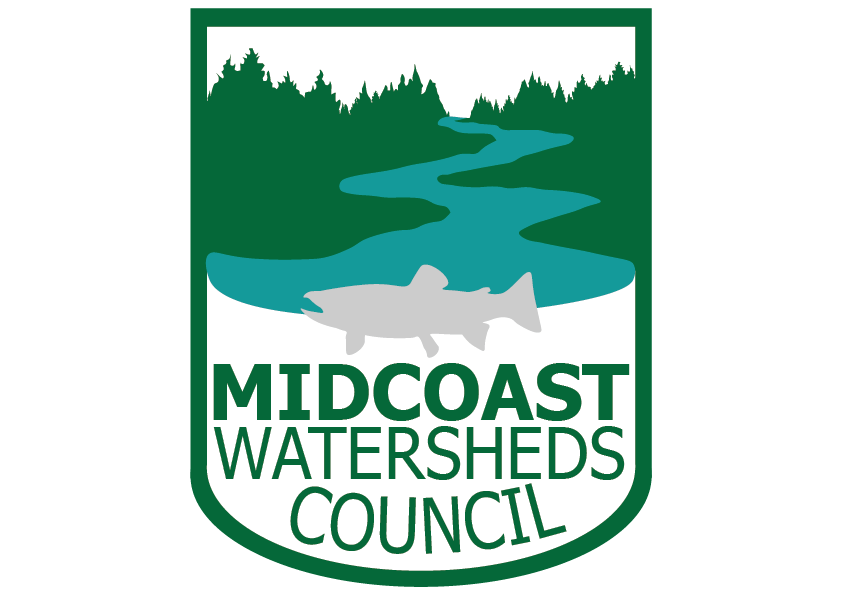The Council is busy! Summer is our season for field work and we are making solid headway on our aquatic habitat restoration projects. We can get out in the field more thanks to our newest employee, Tom McCambridge, who will take over administrative tasks, communications, and outreach roles from our two other staff.
Starting inland, east of the town of Alsea, the first portion of our restoration at Ernest Creek has been completed on the property of the popular Thyme Garden retail nursery. According to Council Coordinator, Evan Hayduk, “It took five years of planning, project development and design, funding acquisition and permitting, and we did the major instream work in 5 days!” Contractors from Trask Design and Construction installed 12 large logjams in the creek, which will provide a complex habitat and provide more opportunities for salmon, trout, and lamprey to spawn. In the fall, the stream side riparian area will be densely planted with conifer species, where a good hardwood canopy already shades the creek. These conifers will increase long term shade, but also provide input of large woody debris to the stream long into the future. MCWC staff will follow up with several years of monitoring the site to ensure the work continues to benefit fish and other species. Interpretive signs will be installed by the landowner on the trail at this site to teach about the benefits of large wood for fish so Thyme Garden visitors can see first hand why this work is so important.
Image 1. Woodjam placement at Earnest Creek. When flow is higher in winter, the wood will provide underwater habitat for spawning salmon and other aquatic organisms.
Moving west into Alsea’s Five Rivers Basin, MCWC and partners from Lane County Public Works will be replacing an undersized culvert on Crazy Creek that has been a nuisance for both migrating fish and the local landowners alike. Once the undersized culvert is replaced with a full spanning bridge, coho salmon and other aquatic organisms such as lamprey will have better access to the more than one mile of high quality habitat upstream of the culvert. The frequent flooding and downstream effects caused by the culvert overflowing will also be solved. This project is slated to start in early August, paired with another culvert replacement on a nearby stream led by Lane County Public Works.
Image 2. The outlet of the Crazy Creek culvert. The 18 inch “perch” or drop at the culvert outlet blocks nearly all passage for juvenile salmon, lamprey species, and other aquatic organisms.
Upriver from Waldport, Trevor Griffiths (the Council’s Restoration Specialist) is collecting water samples to test for the presence of DNA of lamprey and freshwater mussels in partnership with BLM. Additionally, water temperature loggers are being placed to track temperatures in Eckman Creek and lake, as well as other areas in the Alsea Basin. The Council is grateful to our partners at the USFS and multiple landowners for helping us get temperature loggers and analyze the data. Special thanks to Greg Reel and Marathon Products Inc. for their generous donation of temperature loggers to support these projects.
We also have a few projects closer to our office in Newport. On the Yaquina River, we will be working with the Oregon Department of Fish and Wildlife, US Forest Service, and the local landowners (VanEck Forests, managed by Pacific Forest Trust, and The Wetlands Conservancy) to remove approximately 800 cubic yards of non-native fill from a former county road that cuts through a marsh in Poole Slough to increase tidal marsh and estuarine habitat connectivity. With funding from the Siuslaw Collaborative Watershed Restoration program, we will restore full hydrologic connectivity to a portion of Poole Slough.
Image 3. Sitka spruce seedlings grow on a nurse log on Wetlands Conservancy property in Poole Slough, Yaquina Bay. MCWC will place large quantities of large woody debris in Poole Slough to create nurse logs and bolster the area to climate change and sea level rise.
MCWC has received funding from the Pacific Marine and Estuarine Fish Habitat Partnership to place over 200 pieces of large wood in portions of Poole Slough. As the ocean rises, these logs will increase the resiliency of Poole Slough by acting as nurse logs to establish scrub/shrub and spruce swamp habitat. According to MCWC’s extensive 2016 Landward Migration Zones study, we expect these areas to remain or become vegetated tidal wetlands with current estimates of sea level rise. As project partner Fran Recht from the Pacific States Marine Fisheries Commission explains, “Wetlands are incredibly elevation-dependent habitats. As little as a foot of elevation change causes a completely different group of plant species to thrive. We are trying to learn how best to re-establish the once common, but now rare spruce swamp forests.”
Meanwhile, MCWC and partners from Lincoln Soil Water and Conservation District will also continue efforts in both the north and south forks of the ocean tributary Beaver Creek. Five properties have already been planted with native riparian plants, and restoration technicians are cutting back competing, non-native vegetation, so our native species can thrive. The instream work for this summer is more intensive, including reconnecting S. Beaver Creek to its historic meandering channel to increase habitat complexity and quantity. Currently, the creek runs in a straight drainage ditch pushed to the side of one property, simplifying the channel and reducing stream/floodplain interaction. We will also increase habitat complexity by adding many large logs to the stream and floodplain.
As you can see, we’ve been keeping our feet wet and our hands dirty. As always, we could not complete any of this work without the help from our many partners and the support of the public! We are also working on improving our communications so you can stay more up to date on the work we are doing.
Please don’t hesitate to reach out to us with questions, concerns, or ideas. We love to hear from you. Reach us at tom@midcoastwatersheds.org.




